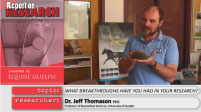ARCHIVE EQUINE NEWS STORIES
| Current news is available at TheHorsePortal.ca, Equine Guelph's online learning platform for practical, quick learning. Given the vast amount of information on horse health and welfare, Equine Guelph has archived its past news articles from 2002-2020. They are listed below, along with a search function available to find specific healthcare topics. | |
Consistency is KeyJanuary 2012
Click here for Report on Research Video Volume 2
by Jackie Bellamy
A number of factors affect the performance of a racing or training surface according to the well received 34-page "Racing Surfaces White Paper" published in June this year. This international publication is a survey of current understanding on ways to enhance track safety, and is co-authored by an esteemed panel including: Michael “Mick” Peterson, Ph.D., University of Maine, United States; Lars Roepstorff, DVM, PhD, Swedish University of Agricultural Sciences, Sweden; Jeffrey J. Thomason, PhD, University of Guelph, Canada; Christie Mahaffey, MPhil, University of Maine, United States; C. Wayne McIlwraith, BVSc, PhD, Colorado State University, United States.
Though there is still much research to be done since the forming of the racing surfaces committee at the inaugural Welfare and Safety of the Racehorse Summit in 2006, this publication will benefit trainers, track superintendants and any person in charge of riding surfaces. Details of proper maintenance of surfaces and training guidelines can be found, based on the knowledge gained from the researcher’s findings thus far. The download is available at grayson-jockeyclub.org/resources/White_Paper_final.pdf.
Climate and maintenance are two of many factors analyzed by the researchers looking for the best possible training surface conditions to enhance safety for the horse and rider. The Racing Surfaces White Paper publication will have future applications in helping in the design of tracks, in terms of banking and cushioning properties in track surfaces not only in racing but in training as well. U of G, Co-author Dr. Jeff Thomason notes, “Horse industry leaders, interested in creating an optimum surface to help minimize injuries in the limbs of horses, will be interested in following this research”.
Thomason is pleased to be a part of this White Paper publication. It is the most comprehensive scientific body of research on race tracks to date; yet it is just scratching the surface. New questions have been cultivated requiring further investigation. Thomason will continue to be involved with this collaborative research with targeted studies on the effect of racetrack characteristics on the horse-hoof-track interaction.
With so many variables in play the next steps in research are always, short very specific experiments with a narrow focus (e.g., the effect of different height toe grabs or different shoes on the same surface). “It is only by meticulously piecing together the answers of each precise question that you begin to see the big picture” says Thomason. Studying the influences of forces and loads and the mechanics of loading on the hoof itself is an integral part of Thomason’s research. One method used to measure these forces is by gluing lightweight sensors to a horse’s hooves before it goes out to the training track. These sensors have been used to record two kinds of data: strain and shock.
With so many track surface options available (including synthetic, dirt or turf), Thomason is often asked what the best option is. The preponderance of evidence at the moment suggests the consistency of the surface is more important than the material it is made of. A well-maintained all-weather track is desirable. The track should be consistent around its circumference. Three unknown topics requiring further research are: 1) the range of hardness or softness that is not dangerous to the horse. 2) How well does water need to run off a track? 3) Do track surfaces need to have different properties for the impact as opposed to the sliding? Research proves good maintenance is an extremely important component for providing consistency and improving safety. Of course, the track has to be well constructed to start with. Regular maintenance includes light harrowing between races to level the hoof prints left in the ground. Deeper harrowing, as required, provides a cushion at the top of the surface. One superintendent reported a 30 - 40% reduction in catastrophic fractures at his track after attending a meeting of superintendents in North America and adopting the consistency maintenance program outlined in the White Paper.
Climate also plays a vital and complicated role in determining maintenance. Thomason reminisces, “Where I grew up, in England, the climate consisted of ample rain and you heard about the going being sloppy, firm or good. This would be a measure of how slippery or firm the track was.” Conversely California has problems with the surface becoming too dry. Artificial surfaces were designed to give a surface that was consistent. This has not been achieved yet. Even artificial surfaces change their properties throughout the day when the sun comes out. In the morning the surface becomes softer and records indicate the racing times slow down throughout the day showing a very local effect of sunny climate on the track.
Thomason spends much of his time understanding the complexity of how the hoof interacts with the ground from absorbing the shock of impact to the abrasion of grinding into the surface and how the weight of the horse is distributed. One excerpt of the Whitepaper states: As the soil or top layer of the turf compacts, it becomes stiffer and more resistant to further compaction, bringing the hoof to a stop (Thomason and Peterson 2008). Once the motion of the hoof has been slowed or has stopped, the weight of the horse is dynamically transferred to the hoof and then to the harder surface material beneath the hoof. This dynamic transfer of the weight of the horse to the hoof is the source of the acceleration, resulting in peak loads which may approach 2.5 times the bodyweight of the horse.
The hardness of the track influences how quickly the foot is decelerated and then the stiffness of the track when the load is being applied. This rate of deceleration controls the strain which is transferred to the leg and results in higher peak loads for stiffer surfaces. Repeated loading to the bone can cause micro fractures and the catastrophic fractures (Radin et al. 1972). Horses and their owners stand to benefit from this research when new information is discovered regarding how to reduce the factors causing injuries on limbs.
Jeff Thomason’s research has been funded by the Natural Sciences and Engineering Research Council of Canada (NSERC), Equine Guelph and Grayson Jockey Club.
Read - Jeff Thomason biography
Funding for the Report on Research and Help for Horseowners videos has been provided by the Knowledge Translation and Transfer Program under the OMAFRA-U of G Partnership.

